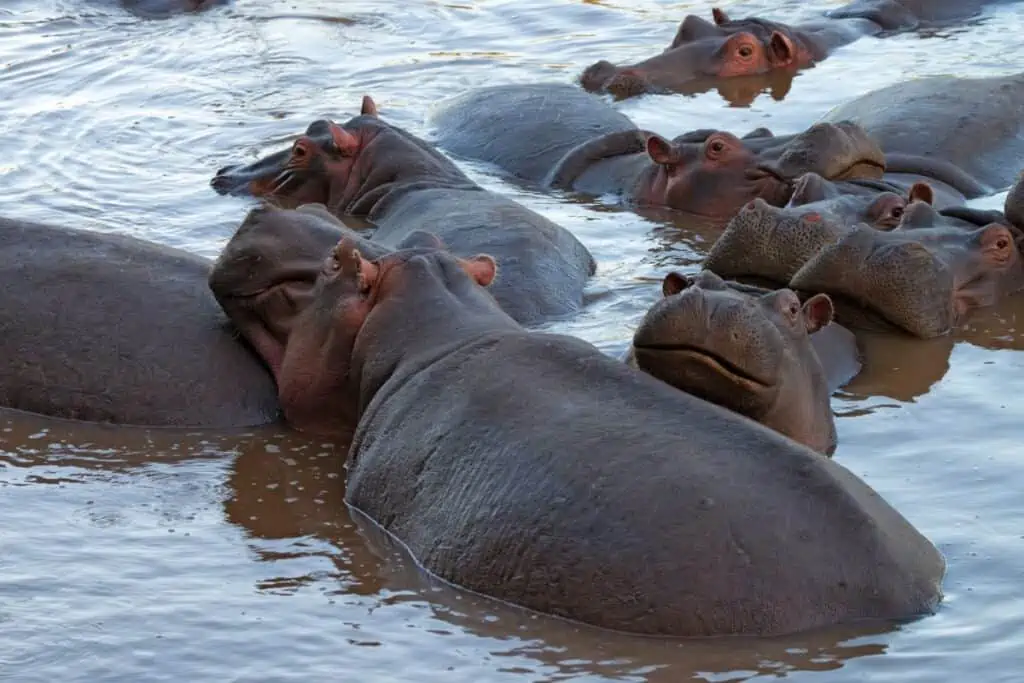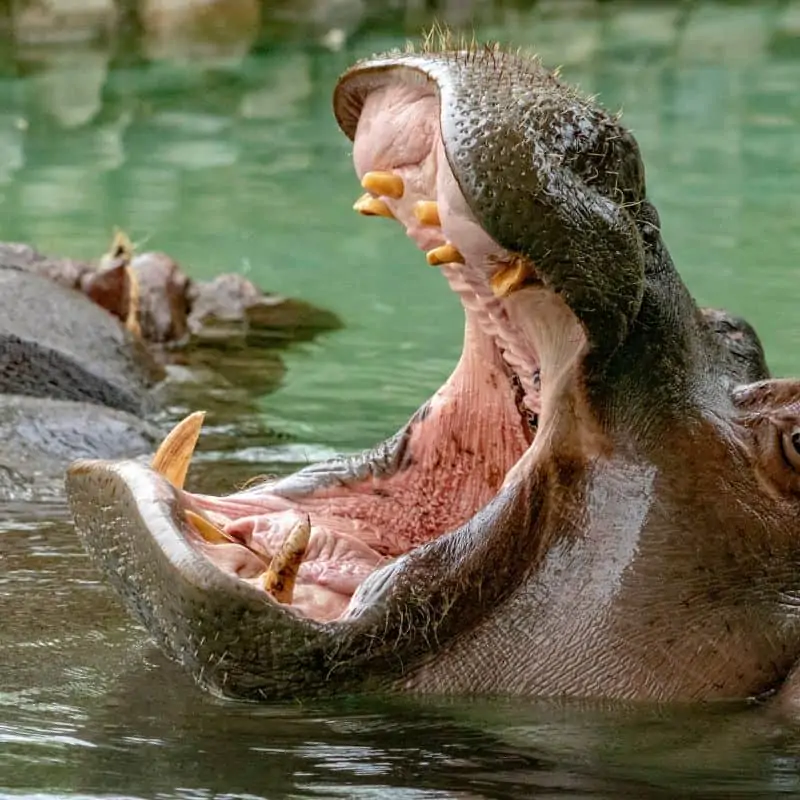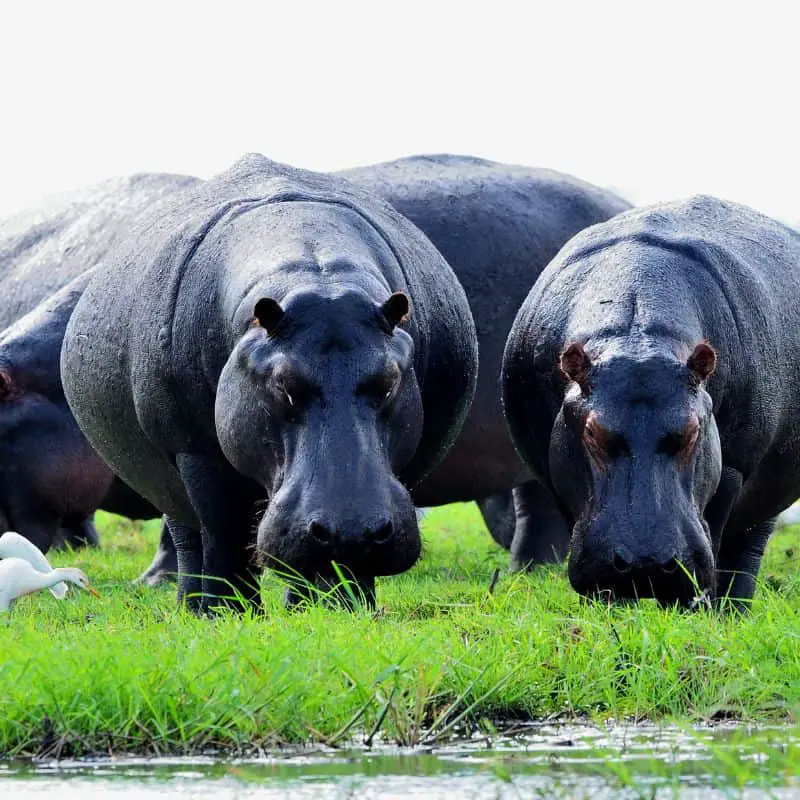With a weight as large as a bulldozer and the speed of an Olympian, it’s no wonder hippos are one of Africa’s most dangerous animals. They may look like giant, blubbery creatures that would rather lounge in the water than do anything else but don’t let their appearance deceive you.
Hippos, related to cetaceans, are the third-largest land mammals in the world. They can’t swim but can hold their breath for 5 minutes and spend 16 hours submerged. Their mouths open to 180 degrees, and they eat 80 pounds per night. The IUCN listed them as vulnerable species.
This article will look at some exciting hippo facts you probably didn’t know.

- Top 12 Facts About Hippos
- 1. Hippos Love The Water
- 2. Hippos Are Really Big
- 3. Hippos Are Deadly
- 4. Hippos Can Reach Top Speeds Just Like Olympic Athletes
- 5. Hippos Are Not Good Swimmers
- 6. Hippos Are Very Good at Holding Their Breath
- 7. Hippos’ Blood Sweat Acts as a Sunscreen
- 8. Hippos Are Closely Related to Dolphins and Whales
- 9. Symbiosis – Fish Help in Cleaning Hippos’ Skin
- 10. Hippos Can Reach Senior Citizen Status
- 11. A Hippo Consumes Up To 80 Pounds Of Food Per Night
- 12. The Hippo Is Being Killed for Its Ivory
- Final Thoughts On Hippos
- FAQs
Top 12 Facts About Hippos
Hippopotamuses are often perceived as cute and cuddly animals, but they are actually quite dangerous. Here are twelve interesting facts about hippopotamuses that you may not know.
1. Hippos Love The Water
Hippos are large, semi-aquatic mammals with round bodies and short legs.
They spend about 16 hours resting in lakes, rivers, and wetlands but come onto land at night to graze on grasses and reeds. They even used to be found in the Nile River.
They are similar to humans and other mammals but can hold their breath underwater for extended periods (5 minutes).
The hippos migrate to the African lowlands nightly several miles (about 6 miles) away from water sources, eating grass for several hours (5-6 hours).
They are even able to mate and give birth while underwater.
2. Hippos Are Really Big
The hippopotamus is a giant among land animals. They are native to Africa and third in line size-wise only behind elephants and White Rhinos, who reign as the two largest land mammals.
Fully grown adult hippos weigh an average of 1.4 to 5 tons and are 2 to 5 meters in length (6 to 16.5 feet), with a standing height of about 1.6 meters (5.2 feet).
3. Hippos Are Deadly
Hippos might look cute and harmless from a distance, but they’re one of the most dangerous animals in the world.
Even though they’re plant-eaters, hippos are still very dangerous animals that can kill humans if we don’t respect their space and keep a safe distance from them.
They Have A Wide Mouth
They have enormous mouths that can open up to 180 degrees and apply ten times more force than human teeth.
Their huge tusks, teeth, and speed make them especially deadly, with around 500 human fatalities occurring yearly.

A Hippo Caused the Death of Thirteen People
A hippopotamus crossing the Niger River killed twelve children and one adult in 2014 by flipping their boat over.
It only takes one chomp from its razor-sharp teeth to crush a human being.
So while it may be tempting to approach these creatures because of how interesting they look, remember that it’s not worth risking your life for.
Eleven Cases of Hippo Bites Reported in One Year
A study conducted over the course of one year found that all patients bitten by a hippo required emergency care at Arche Hospital in Burundi.
Even though one died, most were permanently disabled because of their injuries.
The study’s main finding is that a hippo bite must be treated as a major trauma because it often leads to death.
4. Hippos Can Reach Top Speeds Just Like Olympic Athletes
Olympic athletes aren’t the only ones capable of incredible feats. Although it may seem like hippos are only obese and sluggish, that is not the whole story. They are actually both fat AND fast.
The average weight of a hippo falls between 1.5-4 tons (or 3000-8000 pounds). Their speed is even more impressive; despite their size, they can still run quite quickly, reaching speeds of up to 20 miles per hour.
Their speed, heavy size, large teeth, and strong mouths make them dangerous animals since humans cannot outrun them. Hippos kill more humans in Africa yearly than any other species – even big cats like lions.
5. Hippos Are Not Good Swimmers
Hippos cannot swim. Even though they love the water and have webbed feet, hippos aren’t good swimmers.
They sink to the bottom of rivers because their bodies are so dense.
Hippos are not swimmers but are perfect for walking, galloping, or bouncing in shallow rivers and lakes.
Their bones offer the right weight to achieve optimum buoyancy, effectively turning the river into a microgravity environment.
Hippos can be deceptively fast when moving underwater and on land.
6. Hippos Are Very Good at Holding Their Breath
As hippos spend most of their time submerged in water, they need to be able to hold their breath for long periods.
Adults can last up to 5 minutes without taking a breath, but newborns can only hold theirs for 40 seconds.
Reflexes and adaptations, like the automatic closure of lungs and increased body density, let hippos stay underwater for long periods – they can even sleep underwater.
Their eyes, nostrils, and ears are all on top of their head so they can see, hear, and breathe even when the rest of their body is underwater.
7. Hippos’ Blood Sweat Acts as a Sunscreen
The hippopotamus can’t sweat; when not submerged, the hippopotamus’ skin rapidly dries out. The body secretes an oily substance to keep its skin moisturized, prevent sunburns, and ward off bacteria.
The term “blood sweat” or “red sweat” is often used to describe this secretion, as it gives the hippo a reddish hue.
However, this substance is actually not sweat or blood but turns red-orange after exposure to air and brown eventually.
The hippos secrete two substances in blood sweat, hipposudoric acid (which turns red) and norhipposudoric acid (which turns orange), that act as natural sunscreens.
Not only do these pigments give reddish color to the skin, but they also have antibacterial properties against Pseudomonas and Klebsiella bacteria, which can cause infections.
Interestingly, this is also where the myth of pink hippo milk comes from.
8. Hippos Are Closely Related to Dolphins and Whales
Although they are called hippopotamuses, Greek for “horse of the river,” they are actually not related to horses.
Hippos belong to the order Artiodactyla, which comprises mammals with an even number of toes on each foot, like pigs, camels, and deer, as well as cetaceans (whales, dolphins, and porpoises).
Scientists have found many similarities between hippos and cetaceans, such as nearly hairless skin and underwater births, which confirms that they have common ancestors.
Even today, these animals share many features; for example, both make clicks while moving underwater to aid in echolocation.
9. Symbiosis – Fish Help in Cleaning Hippos’ Skin
Hippos and the fish they share their habitats with enjoy a symbiotic relationship.
Fish, including cichlids and barbels, nibble the dead skin, algae, and parasites on the hippo’s skin and inside their mouths.
This symbiotic relationship benefits both the hippo and the fish, as the fish get a free meal in the form of crud while helping to clean the hippo.
10. Hippos Can Reach Senior Citizen Status
Hippos have been known to live very long lives, and sometimes they even become senior citizens. Although the average lifespan of a hippopotamus is only up to 40 years in the wild, there have been two documented cases of hippos living much longer than that.
- Donna the hippo lived at Mesker Park Zoo, in the United States, in Evansville, Indiana, until she passed away in 2012 when she reached 61 years old.
- The other oldest hippo living in a zoo was Bertha, who resided in the Manila Zoo in the Philippines. She arrived at the zoo when it opened its doors in 1959 and died there 65 years later, in 2017.
11. A Hippo Consumes Up To 80 Pounds Of Food Per Night
Did you know that hippos are actually some of the hungriest animals on the planet? A single hippo can consume up to 80 pounds of grass in just one night!
These massive mammals at night spend hours upon hours (6 hours) grazing on land and munching on any fallen fruit they come across.
For years, it was widely believed that hippos only ate plants. However, in 2015, scientists discovered that these animals would also occasionally eat meat – including the carcasses of other hippos.

12. The Hippo Is Being Killed for Its Ivory
Sadly, the hippopotamus is also being hunted for Ivory, just like elephants and rhinos.
The large canines that they use for self-defense have the same structural material as elephants’ tusks, but hippo ivory is slightly softer and easier to carve.
This makes it more appealing to those who wish to illegally purchase Ivory products, further worsening the problem.
The IUCN’s monitoring agency of international trade reported that the amount of illegal Hippo ivory exports increased in 2008.
The most likely reason for this is the ban on elephant ivory exports in 1989. This would have created a demand for alternative sources of Ivory.
In addition to Ivory, their meat is also highly sought-after. This demand and habitat loss have caused the IUCN to label them as vulnerable species.
It is estimated that there are 115,000 – 130,000 left in the wild.
Final Thoughts On Hippos
The hippopotamus is a genuinely fascinating creature that is often misunderstood. These massive animals are not just hungry herbivores but also capable of crushing their opponents with their powerful jaws.
Even though they may be interesting to look at, refrain from approaching these animals because it’s not worth risking your life.
With their ivory tusks and habitat loss, hippos are becoming an endangered species at an alarming rate. If we want to save these animals for future generations, it is crucial that we learn about them and take action now.

FAQs
Can a Hippo Crush You?
The mouth of the hippopotamus can open up to an angle of 180 degrees. The only weapon that hippos have is their sharp incisors and canines. They will use these teeth to crush any opponent, whether a human, a crocodile, or a lion, in just one blow.
How Strong Is a Hippo’s Bite?
At 12,600 kPa (1800 psi), the hippopotamus has one of the strongest bite forces in the animal kingdom. To put that into perspective, a lion’s bite force is only 4500 kPa. With such a ferocious jaw, uniquely large-mouth, and razor-sharp teeth, this animal can easily bisect an entire human body with just one bite.
